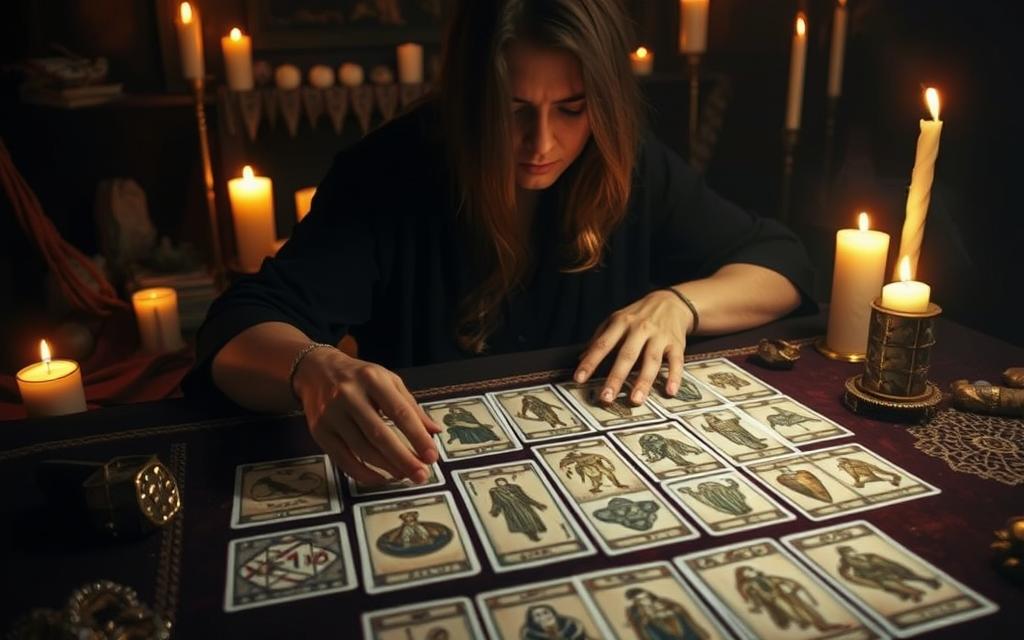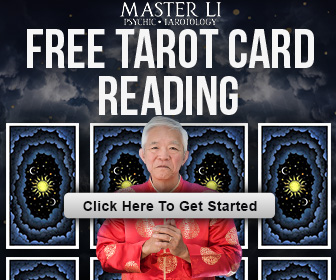A tarot reader serves as a guide, helping individuals tap into the wisdom of the tarot cards to navigate life’s challenges and make informed decisions. Through tarot readings, individuals can gain insights into their current situation, uncover potential outcomes, and explore new perspectives.
By interpreting the symbolism and themes presented in the tarot cards, a skilled tarot reader can offer personalized guidance and support. For those seeking clarity and direction, tarot readings can be a powerful tool for self-discovery and growth.
Whether you’re looking to understand yourself better or seeking guidance on a specific issue, a tarot reader can provide valuable insights to empower your journey forward.
Table of Contents
What is a Tarot Reader: Definition and Purpose
Tarot reading is an ancient practice, and a tarot reader is the conduit through which the symbolism and themes of the cards are interpreted for the seeker. The practice involves not just the technical knowledge of the cards but also an intuitive understanding of the querent’s situation and the context in which they are seeking guidance.
Tarot readers serve as guides, helping individuals navigate life’s complexities by offering insights derived from the tarot cards. The interpretation of these cards is both an art and a skill, requiring a deep understanding of the symbolism, themes, and narratives presented in the deck.
The Core Practice of Card Interpretation
The core practice of tarot reading lies in card interpretation, where the reader analyzes the symbolism, imagery, and narrative of the cards drawn. This involves understanding the traditional meanings associated with each card, as well as the reader’s intuitive response to the card’s imagery and its position in the spread.
- Understanding traditional card meanings
- Interpreting card imagery and symbolism
- Considering the card’s position in the spread
Effective tarot card interpretation requires a balance between knowledge of traditional tarot symbolism and the reader’s intuitive insight. This blend enables the reader to provide a nuanced and personalized interpretation.
Spiritual Advisor vs. Entertainment Provider
A tarot reader can be seen in two distinct roles: as a spiritual advisor or as an entertainment provider. The role they embody depends on their approach, the context of the reading, and the expectations of the querent.
As a spiritual advisor, a tarot reader offers guidance that is meant to inspire reflection, personal growth, and spiritual exploration. In contrast, as an entertainment provider, the focus shifts to a more recreational experience, where the reading is enjoyed for its novelty or entertainment value.
The distinction between these roles is not always clear-cut, and many tarot readers blend elements of both, depending on their professional orientation and the needs of their clients.
The Historical Journey of Tarot Reading
Tracing the historical journey of tarot reading reveals a fascinating story of adaptation and spiritual exploration. The evolution of tarot cards from simple playing cards to complex divination tools is a testament to the dynamic nature of human spirituality and the quest for meaning.
Tarot reading has its roots in 15th-century Europe, where tarot cards were initially used for playing games. Over time, these cards became imbued with symbolic meanings and were adopted by various cultures for divination purposes.
From Playing Cards to Divination Tools
The transition of tarot cards from entertainment to divination tools was a gradual process influenced by various esoteric traditions. By the 18th century, tarot cards had become associated with mysticism and were being used for fortune-telling and spiritual guidance. The Rider-Waite tarot deck, created in the early 20th century, is one of the most influential tarot decks and has played a significant role in popularizing tarot reading worldwide.
Influential Tarot Traditions and Schools
Several tarot traditions and schools have emerged over the centuries, each contributing to the rich tapestry of tarot reading. The French Tarot and the Tarot de Marseille are examples of early tarot traditions that have influenced contemporary practices. Modern tarot reading is also influenced by various esoteric schools, including The Hermetic Order of the Golden Dawn, which has contributed significantly to the development of modern tarot symbolism.
“Tarot cards are a tool for self-reflection and introspection, offering insights into the subconscious mind and the complexities of human experience.”
Tarot Reading in Contemporary Culture
In contemporary culture, tarot reading has become increasingly popular as a tool for personal growth, self-discovery, and spiritual exploration. Many people turn to tarot readers for guidance on various aspects of life, from relationships to career choices. For those interested in exploring tarot reading further, visiting a reputable tarot reader or learning how to read tarot cards can be a rewarding experience. You can find more information on how to engage with tarot reading by exploring resources such as lists of questions to ask the tarot.
| Tarot Tradition | Description | Influence on Modern Tarot |
|---|---|---|
| Tarot de Marseille | One of the oldest known tarot decks, originating in France. | Symbolism and imagery continue to influence modern tarot decks. |
| Rider-Waite Tarot | A widely used tarot deck known for its detailed illustrations. | Popularized tarot reading globally and set a standard for modern tarot decks. |
| The Hermetic Order of the Golden Dawn | A mystical organization that contributed to the development of modern tarot. | Influenced the symbolism and interpretation of tarot cards. |
How Tarot Readers Interpret the Cards
Effective tarot readers combine knowledge of traditional card meanings with intuitive insights to provide accurate readings. This blend of traditional understanding and personal intuition allows tarot readers to offer deep and meaningful interpretations of the cards.
Tarot card interpretation is a complex process that involves understanding the symbolism, imagery, and themes presented on the cards. Readers must consider various elements, including the card’s position in a spread, its relationship to other cards, and the question being asked.
Decoding Symbols, Colors, and Imagery
Tarot cards are rich in symbolism, with each element on a card holding specific meaning. Decoding symbols, colors, and imagery is crucial to understanding the card’s message. For example, the color red often represents passion or energy, while a figure with a crown may symbolize authority or leadership.
To learn more about the historical development of tarot card meanings, you can visit this resource, which provides insights into how tarot cards evolved over time.
Popular Reading Methods and Spreads
Tarot readers use various reading methods and spreads to interpret the cards. A spread refers to the layout of the cards and can range from simple three-card spreads to complex layouts involving multiple cards. Each spread offers a different perspective on the question being asked.
Some popular spreads include the Celtic Cross, which provides a comprehensive view of a situation, and the Three-Card Spread, which offers insights into past, present, and future influences.
Blending Intuition with Traditional Meanings
While traditional meanings of tarot cards provide a foundation for interpretation, intuitive capabilities play a significant role in a reader’s ability to synthesize the information and provide a meaningful reading. Experienced tarot readers balance their knowledge of traditional card meanings with their intuitive insights to offer guidance that is both relevant and personalized.
By combining these approaches, tarot readers can provide readings that are not only informative but also empowering for those seeking guidance.
Essential Qualities and Skills of Professional Tarot Readers
To excel as a tarot reader, one must possess a unique blend of skills and personal qualities. Professional tarot readers are not just knowledgeable about the tarot cards; they are also adept at creating a supportive and insightful experience for their clients.
Empathic Listening and Communication Abilities
Empathic listening is a crucial skill for tarot readers, allowing them to understand the client’s concerns and provide relevant guidance. Effective communication is also vital, as it enables the reader to convey complex ideas and emotions in a clear and compassionate manner. By combining these skills, tarot readers can foster a deeper connection with their clients.
Ethical Boundaries and Responsibilities
Tarot readers must maintain ethical boundaries to ensure a safe and respectful environment for their clients. This includes being aware of their own biases and limitations, as well as being transparent about the nature of tarot readings. For more information on our approach to ethical tarot readings, please visit our Disclaimer Page.
Developing Intuitive and Analytical Capabilities
Tarot readers need to develop both their intuitive and analytical capabilities to provide accurate and meaningful readings. This involves honing their understanding of the tarot symbolism, as well as trusting their instincts to interpret the cards in context. By balancing these skills, readers can offer insightful and practical guidance to their clients.
| Key Skills | Description | Importance |
|---|---|---|
| Empathic Listening | Understanding client concerns | High |
| Effective Communication | Conveying complex ideas clearly | High |
| Ethical Awareness | Maintaining boundaries and transparency | High |
| Intuitive Insight | Interpreting tarot cards intuitively | High |
| Analytical Capability | Understanding tarot symbolism | High |
The Tarot Reading Experience: What to Expect
Embarking on a tarot reading journey can be both intriguing and intimidating, but understanding what to expect can make all the difference. A tarot reading is a personal and interactive experience that can offer insights into one’s life, challenges, and future possibilities.
Before, During, and After Your Reading
Before a tarot reading, it’s helpful to clarify your intentions or questions. During the reading, the tarot reader will shuffle the cards, lay out a specific spread, and interpret the cards based on their symbolism, imagery, and position in the spread. After the reading, take time to reflect on the insights gained and consider how to apply them to your life.
Common Misconceptions About Tarot Readings
Many people harbor misconceptions about tarot readings, viewing them as fortune-telling or associated with dark magic. However, tarot readings are actually a form of self-reflection and guidance. They help individuals understand their current situation, make informed decisions, and navigate future challenges.
| Misconception | Reality |
|---|---|
| Tarot readings predict the future with certainty. | Tarot readings offer insights and guidance based on current circumstances. |
| Tarot readings are associated with supernatural or occult practices. | Tarot readings are a tool for self-reflection and personal growth. |
Finding a Reputable Tarot Reader
To find a reputable tarot reader, look for individuals with a strong ethical foundation, good communication skills, and a clear understanding of tarot symbolism. Check for reviews, ask for referrals, and consider having a preliminary conversation to gauge their approach and compatibility with your needs.
By understanding what to expect from a tarot reading and finding a reputable tarot reader, you can enhance your experience and gain valuable insights into your life’s journey.
Conclusion: The Modern Value of Tarot Reading
Tarot reading has evolved into a valuable tool for self-discovery and guidance, offering numerous tarot reading benefits. With its rich history and diverse traditions, tarot reading continues to provide clarity and answers about one’s life, goals, and aspirations. Experienced tarot readers, having spent years honing their craft, can help individuals navigate life’s challenges and make informed decisions.
The modern value of tarot reading lies in its ability to provide a deeper understanding of oneself and the world around us. By tapping into the symbolism and imagery of the tarot cards, individuals can gain valuable insights into their current situations and future possibilities. As a result, tarot reading has become an increasingly popular practice for those seeking guidance and self-awareness.
Ultimately, the benefits of tarot reading are multifaceted, ranging from personal growth and introspection to spiritual exploration and emotional healing. As individuals continue to seek new ways to navigate life’s complexities, the modern value of tarot reading will remain a relevant and valuable resource.


